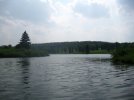- Joined
- Sep 28, 2005
- Messages
- 4,527
I just bought a little 10' Kayak and a 16' canoe and tomorrow may get the canoe out on the water. It's been almost 10 years since I paddled a canoe or kayak, I earned a fair bit of experience through the years but don't "know" what I am doing. We are going to take it easy near shore for the first while. I bought 3 different paddles of different lengths and blade shapes to play with, and 2 kids paddles (2 and 5 year old) that I plan on tying to the boat.
I was just wondering what gear is used in the survival kits in your boats? I am starting to put some things together to have on board. So far I have (all will have bail/rope/whistle/headlight, blue tarps, all in a drysack)
Kayak: "Colt" hatchet/knife combo- not the best quality but is stainless and will get the job done making fire if needed (pocket filled with ~30' each hemp/nylon rope and yellow flagging tape, ferro rod with hacksaw scraper), SAK OHT (is high quality) with aa Maglight (was given them together on a sheath as a set) a couple of hand warmer packs. My wife will be the primary user of this so I have to downsize from what I would want so she is comfortable with the size of the items).
Canoe: Mid sized Wetterlings axe (maybe Estwing), Survival Bivy, small pot with quinoa/tea/granola bar, I'll add various rope, extra gloves/socks, fire starter kit. Not sure what knife goes in it- probably Mora Triflex for now.
At this point all I am looking for is if a day trip on a lake meets bad weather and we have to put to shore for a while/over night, or if something bad happens to the boat and we have to put to shore. We both put fire starter kits and a Gerber River Shorty with us on our PFD's (just bought them yesterday). I hope to add a water filter right away- but we will always have some water with us for unexpected stops.
Bug Dope? Sunscreen? Chapstick? Pocket Flares (local place was out last time I went to get any). Thinking too much beyond basics because I always have survival stuff in my pockets anyways?
Any and all experience is appreciated, it has been a while and I'm in charge this time. Thank you.
I was just wondering what gear is used in the survival kits in your boats? I am starting to put some things together to have on board. So far I have (all will have bail/rope/whistle/headlight, blue tarps, all in a drysack)
Kayak: "Colt" hatchet/knife combo- not the best quality but is stainless and will get the job done making fire if needed (pocket filled with ~30' each hemp/nylon rope and yellow flagging tape, ferro rod with hacksaw scraper), SAK OHT (is high quality) with aa Maglight (was given them together on a sheath as a set) a couple of hand warmer packs. My wife will be the primary user of this so I have to downsize from what I would want so she is comfortable with the size of the items).
Canoe: Mid sized Wetterlings axe (maybe Estwing), Survival Bivy, small pot with quinoa/tea/granola bar, I'll add various rope, extra gloves/socks, fire starter kit. Not sure what knife goes in it- probably Mora Triflex for now.
At this point all I am looking for is if a day trip on a lake meets bad weather and we have to put to shore for a while/over night, or if something bad happens to the boat and we have to put to shore. We both put fire starter kits and a Gerber River Shorty with us on our PFD's (just bought them yesterday). I hope to add a water filter right away- but we will always have some water with us for unexpected stops.
Bug Dope? Sunscreen? Chapstick? Pocket Flares (local place was out last time I went to get any). Thinking too much beyond basics because I always have survival stuff in my pockets anyways?
Any and all experience is appreciated, it has been a while and I'm in charge this time. Thank you.





